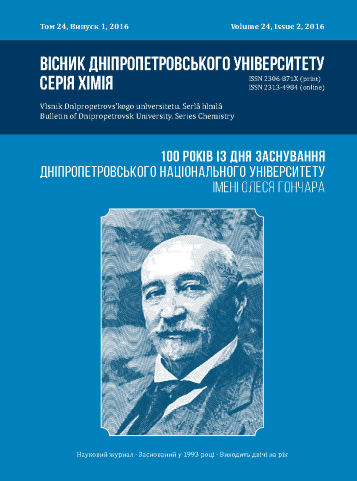N-Alkylation of sulfonamides by alkyl halides in the presence of electrophilic catalysts and transformations of alkylated compounds
DOI:
https://doi.org/10.15421/081610Keywords:
aryl sulfonamides, alkyl sulfonamides, sulfonyl aziridines, Lewis acidsAbstract
Vicinal halo amines constitute an important class of compounds due to their diverse biological activity and a broad application as synthones in the production of pharmaceutical agents. The reaction of aryl- and alkylsulfonamides with 1,2-dibromo-2-phenylethane in the presence of Lewis acids (such as FeCl3 and ZnCl2) in 1,2-dichloroethane can represent one of the most efficient ways of halo amine synthesis. It has been shown that methanesulfonamides and benzylsulfonamides starting materials produced the alkylation products with good yields while p-toluenesulfonamides appeared to be less active and 6-methyl-3-nitrobenzylsulfonamides did not give the expected compounds. It has been found that synthesized vicinal halo amides can easily cyclize in alkaline conditions to give 1-sulfonylaziridines. The regioselectivity of aziridine ring opening has also been studied. It was established that strong nucleophile attacks terminal carbon which leads to the breaking-up of 1–3 bond and subsequent aziridine ring opening. In contrast, weak nucleophiles (water, potassium rhodanide, hydrogen bromide) trigger the cleavage of aziridine cycle by breaking-up of 1–2 bond under acidic conditions which is in accordance with molecular orbital theory. Substituents at the aromatic ring of sulfonyl fragment do not influence on the pathway of aziridine ring opening.References
Kasyan, L. I., Kasyan, A. O., Okovityy, S. I., & Tarabara, I. N. (2009). [Amine-containing scaffolds and their derivatives]. Dnepropetrovsk, Ukraine: Dnepr. Nats. Univ. (in Russian).
Kasyan, L. I., Palchikov, V. A., & Tokar A. V. (2012). [Oxazaheterocycles generated from amino alcohols, epoxides and aziridines]. Dnepropetrovsk, Ukraine: Izd. Dnepr. nats. univ (in Russian).
Burmistrov, S. I., Markov, V. I., & Doroshenko V. A. (1965). USSR Patent no. 172773 Byul. izobret. (in Russian).
Huang, J., & O’Brien, P. (2006). Two-Step Synthesis of N-sulfonyl aziridines from epoxides. Synthesis, 3, 425–434. doi:10.1055/s-2006-926282 CrossRef
Martinez-Asencio, A., Ramon, D., & Yus, M. (2010). N-Alkylation of poor nucleophilic amine and sulfonamide derivatives with alcohols by a hydrogen autotransfer process catalyzed by copper(II) acetate. Tetrahedron Lett., 51, 325−327. doi:10.1016/j.tetlet.2009.11.009 CrossRef
Shi, W., Bai, C., Zhu, K., Cui, D., & Zhang, C. (2014). Bronsted acid-assisted N-alkylation of sulfonamides using ethers as the alkylation reagents. Tetrahedron, 70, 434−438. doi:10.1016/j.tet.2013.11.036 CrossRef
Demir, S., Coşkun, F. Özdemir, İ. (2014). The first used half sandwich ruthenium(II) complexes bearing benzimidazole moiety for N-alkylation of amines with alcohols. J. Organomet. Chem., 755, 134−140. doi:10.1016/j.jorganchem.2014.01.007 CrossRef
Demir, S., Damarhan,Y., Özdemir, I. (2015) Functionalized ionic liquids based onimidazolium cation: Synthesis, characterization and catalytic activity for N-alkylation reaction. J. Mol. Liq., 204, 210−215. doi:10.1016/j.molliq.2015.01.051 CrossRef
Sun, J., Jin, X., Zhang, F., Hu, W., Liu, J., & Li R. (2012). Ni–Cu/γ-Al2O3 catalyzed N-alkylation of amines with alcohols. Catal. Commun., 24, 30–33. doi:10.1016/j.catcom.2012.03.010 CrossRef
Zhang, Ya., Qi, X.., Cui, X., Shi, F., & Deng, Yo. (2011). Palladium catalyzed N-alkylation of amines with alcohols. Tetrahedron Lett., 52, 1334–1338. doi:10.1016/j.tetlet.2011.01.059 CrossRef
Kuznetsova, N. G. (2010). [Synthesis of aziridines and cyclic propanes with dialkylphosphate fragment]. Nizhny Novgorod, Russian Federation (in Russian).
Elderfild, R. (1961) [Heterocyclic compounds (Vol. 1)] Moskow, USSR (in Russian).
Markov, V. I., & Burmistrov, S. I. (1965). [1-Arenesulfonyl-2,2-dimethylethylenimides. Reactions with hydrochloric acid, hydrogen sulphide, methanol]. Zhurn. obshch. khimii – J. Gen. Chem., 35(1), 153–158 (in Russian).
Baldwin, J. E., Spivey, A. C., Schofield, C. J., & Sweeney, J. B. (1993). Amino acid synthesis via ring opening of N-sulphonyl aziridine-2-carboxylate esters with organometallic reagents. Tetrahedron, 49(28), 6309–6330. doi:10.1016/S0040-4020(01)87968-0 CrossRef
Dewar, M., & Ford G. (1979). Relationship between olefinic π-complexes and three-membered rings. J. Am. Chem. Soc., 101(4), 783–791. doi:10.1021/ja00498a001 CrossRef
Downloads
Published
Issue
Section
License
Copyright (c) 2016 Oles Honchar Dnipropetrovsk National University

This work is licensed under a Creative Commons Attribution 4.0 International License.
- Authors reserve the right of attribution for the submitted manuscript, while transferring to the Journal the right to publish the article under the Creative Commons Attribution License. This license allows free distribution of the published work under the condition of proper attribution of the original authors and the initial publication source (i.e. the Journal)
- Authors have the right to enter into separate agreements for additional non-exclusive distribution of the work in the form it was published in the Journal (such as publishing the article on the institutional website or as a part of a monograph), provided the original publication in this Journal is properly referenced
- The Journal allows and encourages online publication of the manuscripts (such as on personal web pages), even when such a manuscript is still under editorial consideration, since it allows for a productive scientific discussion and better citation dynamics (see The Effect of Open Access).


